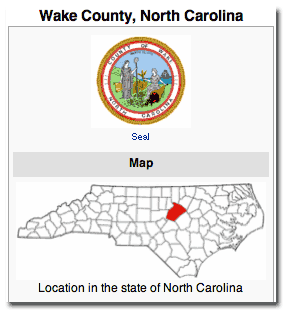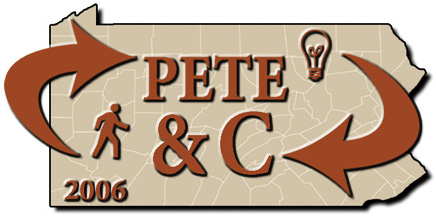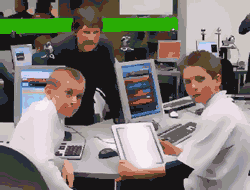Jude2004 celebrated his 51st birthday yesterday. In his comment on Act like Natives, he (or she) claims to know more about technology than his students. He claims to be a native. Do I believe him? I sure do.
 Yesterday I had the pleasure of presenting to nearly 200 school technology contact people here in Wake County (Raleigh). They were teachers, media specialists, a couple of assistant principals, and a handful of tech facilitators. I like to start this presentation by harkening back to those giddy days just before the Web, when a very few of us were paying attention, and recognizing that something BIG was on the horizon.
Yesterday I had the pleasure of presenting to nearly 200 school technology contact people here in Wake County (Raleigh). They were teachers, media specialists, a couple of assistant principals, and a handful of tech facilitators. I like to start this presentation by harkening back to those giddy days just before the Web, when a very few of us were paying attention, and recognizing that something BIG was on the horizon.
I asked how many of them had used Gopher. About three-forths of the hands went up. This surprised me. I asked about Telnet. Again, a vast majority of the hands when up. Then I asked how many had heard of blogs, and to no surprise, most of the hands went up. But when I asked..
How many were blogging, I saw only three hands.
How many read blogs? Perhaps 20.
How many had listened to a podcast? Maybe ten.
How many had podcasted? Zero!
How many used flickr? Zero!
How many knew about social bookmarks? Zero!
Delicious (del.icio.us)? Zero!
An interesting number, zero. On a school paper, it means you didn’t do your assignment.
These are educators who, in the early 1990s, were on the edge. They were paying attention, recognizing an emerging revolution in information, and latching on. What happened between then and now? Why have they missed the new revolution?
Am I missing something?
Or could it be, that the continuing dominant teaching tool of today’s classrooms, the textbook, could not possibly hold any information about the new web? Could it be that we have come such a short distance in our schools since 1990, that our teachers are less equipped, less encouraged, and far less free to pay attention to the world around them, than they were more than a decade ago?
We desperately need… we may not survive without… a generation of young people who are imaginative, inventive, fearless learners, and compassionate leaders. Yet, what can we say, as educators, about the students we are producing. We can prove that they can read, do basic math on paper, and they are able to sit for hours filling in bubble sheets.
No generation in history has ever been so thoroughly prepared for the industrial age.
How have we allowed ourselves to be led by such a miserable lack of imagination?
I have got to get out of this funk!
 Day one is over, and today, I get to play, at PETE & C. Yesterday’s workshop was tough. I taught about 110 educators, mostly tech directors from across Pennsylvania — and it was hands-on. The folks from Prismworks are to be commended. The network served us flawlessly. A couple of the web applications that we explored crashed under the load, but everyone recognized that we were applying un-natural stress.
Day one is over, and today, I get to play, at PETE & C. Yesterday’s workshop was tough. I taught about 110 educators, mostly tech directors from across Pennsylvania — and it was hands-on. The folks from Prismworks are to be commended. The network served us flawlessly. A couple of the web applications that we explored crashed under the load, but everyone recognized that we were applying un-natural stress.
 I should have written about this earlier in the week. But it’s been one of those times where your struggling just to be ready for tomorrow. Tomorrow, I’ll be teaching a workshop for education technology leaders (Tech directors) throughout Pennsylvania, as one of the preconference workshops at PETE & C. The topic will be Web 2.0 (Changing Shape of Information), but our focus will be on the potentials of using new web techniques as a way for structuring management and change networks within a school district and across the state.
I should have written about this earlier in the week. But it’s been one of those times where your struggling just to be ready for tomorrow. Tomorrow, I’ll be teaching a workshop for education technology leaders (Tech directors) throughout Pennsylvania, as one of the preconference workshops at PETE & C. The topic will be Web 2.0 (Changing Shape of Information), but our focus will be on the potentials of using new web techniques as a way for structuring management and change networks within a school district and across the state. Yesterday I had the pleasure of presenting to nearly 200 school technology contact people here in Wake County (
Yesterday I had the pleasure of presenting to nearly 200 school technology contact people here in Wake County ( Many many thanks to Wes Fryer for podcasting David Thornburg’s presentation at the TCEA conference last week in Austin. I can remember watching folks like Thornburg and Alan November back ten years ago, and saying to myself, “I could do that! And I think I could do it that well!” Both of these guys have simply gotten better and better. Thornburg does an amazing job of bringing Open Source down to earth, for us non-techie folks. This in itself point’s to David’s talent, given his astounding creds as high-order geek (principle scientist as Xerox PARC in the early ’70s).
Many many thanks to Wes Fryer for podcasting David Thornburg’s presentation at the TCEA conference last week in Austin. I can remember watching folks like Thornburg and Alan November back ten years ago, and saying to myself, “I could do that! And I think I could do it that well!” Both of these guys have simply gotten better and better. Thornburg does an amazing job of bringing Open Source down to earth, for us non-techie folks. This in itself point’s to David’s talent, given his astounding creds as high-order geek (principle scientist as Xerox PARC in the early ’70s). My initial (and too glib) answer was, “It isn’t a matter of ‘if’. It’s ‘when’.” That being said, it’s a task I wouldn’t wish on a friend. First of all, it won’t work in a 20th century classroom. The formula is much more complex and the questions are too deep to think that simply putting laptop or tablet PCs in the hands of your students will make them smarter, and better prepare them for their future — and these very smart people knew that already.
My initial (and too glib) answer was, “It isn’t a matter of ‘if’. It’s ‘when’.” That being said, it’s a task I wouldn’t wish on a friend. First of all, it won’t work in a 20th century classroom. The formula is much more complex and the questions are too deep to think that simply putting laptop or tablet PCs in the hands of your students will make them smarter, and better prepare them for their future — and these very smart people knew that already.  You’ve all heard by now that our president’s budget proposal is out for 2007, and that with the exception of military and homeland security, programs are getting cut. A third of the 141 programs to be scaled back or eliminated are in education. He proposes cutting department of education funding by 3.5 billion dollars, zeroing out educational technology funding (E2T2) all together.
You’ve all heard by now that our president’s budget proposal is out for 2007, and that with the exception of military and homeland security, programs are getting cut. A third of the 141 programs to be scaled back or eliminated are in education. He proposes cutting department of education funding by 3.5 billion dollars, zeroing out educational technology funding (E2T2) all together.